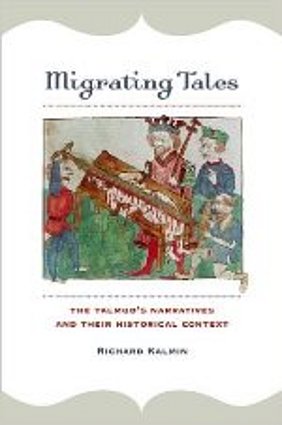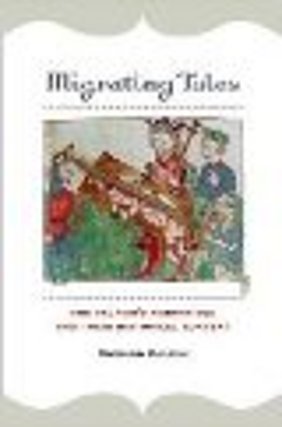Like his previous book, Jewish Babylonia between Persia and Roman Palestine (2006), Richard Kalmin’s Migrating Tales represents an attempt to understand the literature of the Babylonian Talmud in its cultural context. While the earlier book focused on Palestinian rabbinic and Persian Christian traditions, this book considers Talmudic narratives against non-rabbinic narratives, both Christian and pagan, from the Roman East. Kalmin’s readings support his contention that there was a growing “cultural unity” that crossed the borders of the two major empires of the time, Rome and Sasanian Babylonia. He argues that the rabbis of the Babylonian Talmud were influenced by both Mesopotamian Christians and groups in the eastern Roman Empire. This influence can be attributed in part to Persian conquest of portions of the eastern Roman Empire in the third century and again in the sixth. The book also considers the Babylonian rabbis’ awareness of Christianity and relations between the two religions in this period.
Each chapter of this carefully researched and clearly written book focuses on a Talmudic narrative with parallels in non-rabbinic literature. In chapter 1, Kalmin seeks to demonstrate that the fourth century marks the beginning of eastern Romanization of Jewish Babylonia through an analysis of the relationship between passages from the Ascension of Isaiah, generally dated to the late first or early second century CE, and the Bavli’s account of the execution of Isaiah by Manasseh. Kalmin opens with an analysis of the relevant passages in the Ascension, then introduces the text from the Bavli. He then brings in later Persian and Muslim narratives that share motifs with the two accounts. Kalmin notes both the similarities and the differences between the sources, and concludes with a proposed chronological and geographical map for the stories and common motifs. In chapter 2, he argues for links between Jewish and Christian traditions through an analysis of bMeilah 17a-b, proposing that the Bavli took traditions about the apostle Bartholomew and reshaped them into an account of R. Simeon ben Yohai exorcising a demon named Bar Thalamion. The chapter includes a detailed discussion of the editing process that produced the passage and observations about the significance of switches from Hebrew to Aramaic in the Bavli.
The third chapter focuses on the various accounts, both Jewish and non-Jewish, of the creation of the Septuagint, the Greek translation of the Torah by Jewish scholars. Kalmin claims that contemporaneous versions of the story in the Bavli and a Syriac Christian text from Mesopotamia suggest that the two had “a common source deriving from the eastern Roman provinces, or Christian literature [as] a source for the Bavli’s tradition” (p. 83). His analysis of the relationship among the accounts also considers the ancient rabbis’ attitude toward the Septuagint. Chapter 4 explores parallels between the Testament of Solomon and Bavli Gittin 68a-b’s account of Solomon and the demon Ashmedai. Kalmin argues that the similarities in these accounts support his claims for the migration of traditions from the Roman East to Mesopotamia, not via the Testament of Solomon, a medieval compilation, but through sources no longer extant. In this chapter, Kalmin also considers the ways the Babylonian rabbis reshaped traditions they took from the Roman East to reflect their cultural context and further their claims of authority.
The fifth chapter contains what may well be the most ambitious study in this book. Kalmin analyzes Jewish, Christian, and Muslim traditions about a murder in the Temple that resulted in blood that remained long after the murder was committed. The murder of Zechariah, identified in some versions of the account with the post-exilic prophet Zechariah, in some with the father of John the Baptist, and in others with the pre-exilic prophet Zechariah ben Jehoiada, becomes a vehicle for exploring the complex history of a story. Working with sources dated to the first through the thirteenth centuries CE, Kalmin attempts to reconstruct the earliest version of the story and explain the variations that arose over a thousand years. He posits an early Hebrew version of the story shaped by Christians, which later found its way into rabbinic sources, but which also influenced later Christian and Muslim stories.
In chapter 6, Kalmin argues that some of the Bavli’s traditions about the Pharisees were most likely derived from the New Testament. He carefully analyzes a passage on bSotah 22b and notes similarities to the New Testament’s critique of the Pharisees. Kalmin also presents material from Josephus and from the Yerushalmi, carefully building his case for the likelihood that “the Bavli inherited ... traditions ... either directly from the Roman East or indirectly via Syriac translations from Mesopotamia” (p. 167). In chapter 7, Kalmin turns his attention to Talmudic stories about astrology, demonstrating that the notion that “Israel is not subject to astrological influence” (bShabbat156b) “reached Babylonia from Jewish, Christian, or pagan sources from the eastern Roman provinces ... during the fourth century” and that the Bavli’s discussion of fate can best be understood in the context of Roman and Zoroastrian ideas on the subject (p. 199). The eighth and final chapter explores a passage in bTamid about Alexander the Great, noting its similarities to accounts of Alexander in Greek works; once again, Kalmin, through analysis of style and content, argues for the influence of traditions from the Roman East on the Babylonian Talmud.
Kalmin is a thorough and careful reader. He explicates both rabbinic literature and non-rabbinic literature in detail, walking the reader through disparate sources and offering the necessary background information. Kalmin is also to be commended for well-balanced scholarship that offers theories as to how the rabbis’ compilations were influenced by external sources but acknowledges the gaps in our knowledge of precisely how the process of transmission occurred. He recognizes the difficulties in determining the extent to which the editors of a given text may have been aware of another text; he speaks of shared cultural motifs or traditions rather than always insisting that the rabbis knew the works of Christian writers or vice versa.
There may be some readers who will find some of Kalmin’s arguments too far reaching. Others may feel that he is crediting the Roman East, as opposed to Babylonia, with too much influence on the Bavli. However, such concerns, while understandable, in no way lessen the importance of his work. This book reminds us that the complex work that is the Babylonian Talmud becomes richer when we read it in its cultural context, acknowledging that its use of non-rabbinic and even non-Jewish traditions is natural, while its reworking of those traditions serves as a testimony to the Bavli’s unique voice and agenda. Kalmin has provided scholars of late antique Judaism with a valuable resource for thinking about Jewish culture and ideas.



